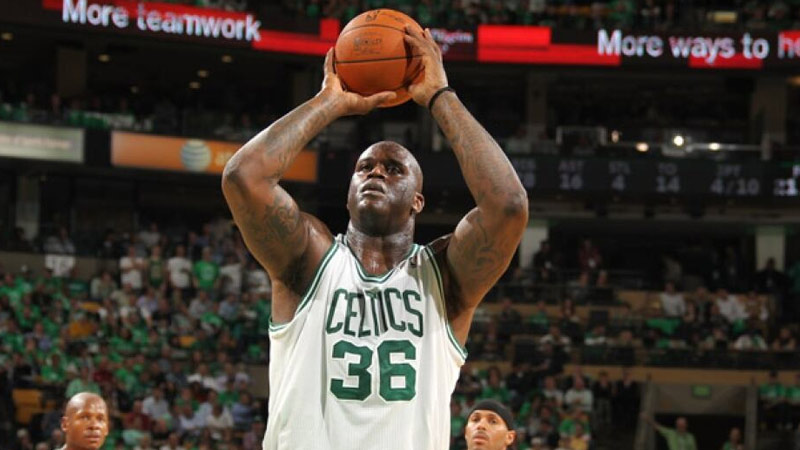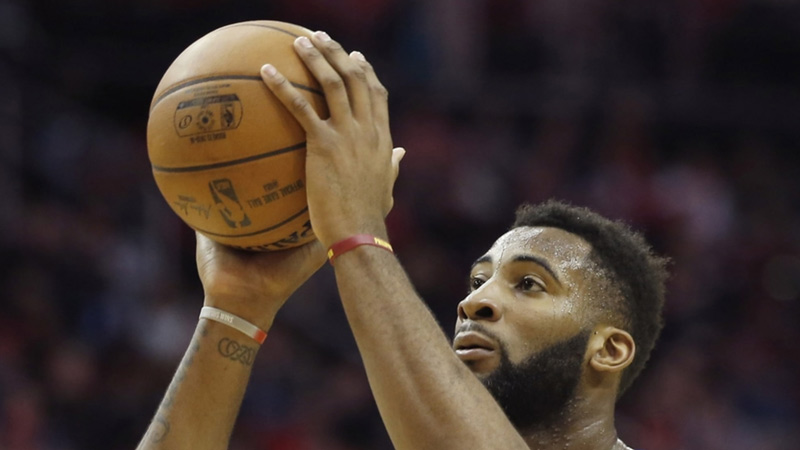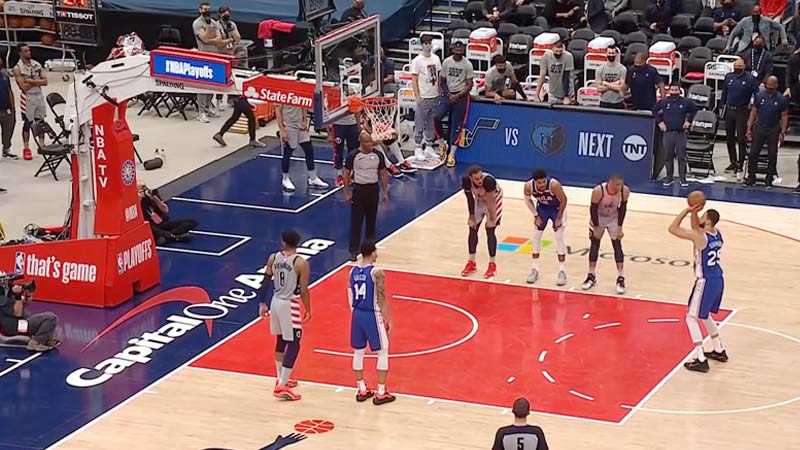Hack-a-Shaq is a controversial strategy in basketball, especially in the NBA, where a team intentionally fouls a poor free throw shooter to prevent the opposing team from scoring.
The term Hack-a-Shaq was coined after Shaquille O’Neal, a dominant center who was notoriously bad at free throws. All fans and players alike should know about this fact.
By sending him to the foul line, his opponents hoped to limit his impact and disrupt the offensive flow of his team. Let’e get into a deep discussion in the following sections.
Hack-a-Shaq In Basketball?
Hack-a-Shaq is a basketball strategy that gained prominence in the late 1990s and early 2000s, named after NBA Hall of Famer Shaquille O’Neal.
The term refers to intentionally fouling a poor free-throw shooter, often a player with a low free-throw percentage, in order to force them to shoot free throws.
The strategy aims to exploit the player’s weakness at the free-throw line and reduce their team’s scoring efficiency.
The Hack-a-Shaq strategy typically involves a deliberate and excessive fouling of the targeted player whenever they have possession of the ball, but are not in the act of shooting.
Hack-a-Shaq In NBA
The NBA is the most popular and competitive basketball league in the world, where the best players showcase their skills and talents.
However, some players have a glaring weakness in their game: free-throw shooting. Free throws are unguarded shots from a fixed distance that are awarded after a foul.
They are worth one point each and can make a difference in close games. Some players, especially big men who play near the basket, have a low percentage of making free throws, which makes them vulnerable to the Hack-a-Shaq strategy.
What is Hack-a-Shaq Rule In Basketball?

Source: cbc.ca
The “Hack-a-Shaq” rule in basketball refers to a strategic tactic employed by teams to intentionally foul poor free-throw shooters, particularly dominant centers like Shaquille O’Neal.
This strategy aims to exploit the player’s weakness at the free-throw line and reduce the opposing team’s scoring potential. To address this tactic, the NBA introduced a rule to discourage excessive and deliberate fouling away from the ball.
Here are the key points regarding the Hack-a-Shaq rule:
Purpose
The Hack-a-Shaq strategy emerged as a response to dominant players, such as Shaquille O’Neal, who struggled with their free-throw shooting.
By intentionally fouling these players away from the ball, teams could send them to the free-throw line where they had a lower shooting percentage, thus limiting their scoring impact.
Strategy
The team implementing the Hack-a-Shaq strategy would instruct its players to commit fouls intentionally on the targeted player whenever they did not have possession of the ball. This would force the poor free-throw shooter to step to the line and attempt free throws.
Delay of Game
In some cases, teams utilizing the Hack-a-Shaq strategy would repeatedly commit fouls away from the ball to disrupt the flow of the game and slow down the opposing team’s offense. This would extend the duration of the game and potentially frustrate opponents.
Rule Implementation
In response to the prevalence of the Hack-a-Shaq strategy and its impact on the game, the NBA implemented a rule to discourage excessive fouling away from the ball.
The rule, introduced in the 2016-2017 season, stated that deliberate fouls committed away from the ball in the last two minutes of each quarter would result in one free throw and the offended team retaining possession of the ball.
Two-Minute Rule
The Hack-a-Shaq rule primarily applies to the last two minutes of each quarter, including overtime periods.
During this time frame, intentional fouls away from the ball result in one free throw and the offended team retaining possession, regardless of whether the team is in the bonus or not.
Offensive Players Only
The Hack-a-Shaq rule specifically applies to intentional fouls committed on offensive players away from the ball. If the player with the ball is fouled intentionally, the normal free-throw shooting rules apply.
Discretion of Officials
The officials have the authority to determine whether a foul was committed intentionally or whether the player had a legitimate opportunity to make a play on the ball. If they deem the foul to be intentional, the Hack-a-Shaq rule is enforced.
Controversy
The Hack-a-Shaq strategy and the subsequent rule have sparked debates among fans, players, and coaches.
Supporters of the rule argue that it preserves the integrity and flow of the game, while opponents argue that it penalizes players for their poor free-throw shooting and alters the strategic aspect of the game.
The Hack-a-Shaq rule was implemented to discourage excessive fouling away from the ball, particularly targeting poor free-throw shooters.
By imposing penalties on intentional fouls in the last two minutes of each quarter, the rule aims to maintain the flow and fairness of the game while addressing the strategic implications of intentional fouling.
Significance of Hack-a-Shaq In Basketball

Source: fansided.com
This strategy has sparked extensive debates and criticism among fans, players, coaches, and analysts due to its impact on various aspects of the game.
Now, we will delve into the significance of the Hack-a-Shaq strategy, exploring both its supporters’ and opponents’ viewpoints.
Improvement of Free Throw Shooting
One of the arguments in favor of the Hack-a-Shaq strategy is that it serves as a smart and legitimate tactic to exploit opponents’ weaknesses and force them to improve their free throw shooting.
By intentionally fouling poor free-throw shooters, teams aim to disrupt their opponents’ offensive flow and potentially reduce their scoring efficiency.
This strategy puts pressure on players to develop their free throw skills, ensuring a well-rounded performance on the court.
Entertainment Value and Game Integrity
On the other hand, critics argue that the Hack-a-Shaq strategy is a cheap and boring way to play that diminishes the entertainment value and integrity of the game.
Supporters of this viewpoint contend that intentional fouls disrupt the flow and rhythm of the game, leading to frequent stoppages and elongating the overall duration of the match.
This strategy can result in less fluid and exciting gameplay, potentially alienating fans and diluting the spectacle of basketball.
Impact on Player Statistics, Records, and Awards
The Hack-a-Shaq strategy has a direct impact on the statistics, records, and awards of the players involved. When a player is intentionally fouled, they are given free throw attempts.
If they struggle with free throw shooting, their field goal percentage and scoring average can be negatively affected.
Additionally, intentional fouls can result in players accumulating more personal fouls, potentially limiting their playing time due to disqualification or foul trouble.
Consequently, this strategy can alter the individual records and achievements of players, influencing their overall legacy in the sport.
Pace, Outcome, and Duration of Games
The implementation of the Hack-a-Shaq strategy can significantly impact the pace, outcome, and duration of basketball games.
Intentional fouls not only slow down the game due to the resulting free throw attempts but can also disrupt the momentum and rhythm of teams.
In closely contested matches, the Hack-a-Shaq strategy can be a strategic tool for teams to narrow the point differential or catch up in the score.
This strategy has the potential to influence the final outcome of games and contribute to exciting comebacks or unexpected upsets.
Penalties for Violating Hack-a-Shaq
The Hack-a-Shaq rule refers to a strategy in basketball where a team intentionally fouls a poor free-throw shooter, often resulting in the fouled player going to the free-throw line.
While the rule was implemented to discourage excessive intentional fouling, the penalties for violating this rule are not particularly severe.
In this section, we will discuss the penalties associated with violating the Hack-a-Shaq rule and explore the various implications and consequences that arise as a result.
Penalty Description
When the Hack-a-Shaq rule is violated, the penalties imposed are relatively minor compared to other violations in basketball.
The fouled team is awarded one free throw and retains possession of the ball. This provides the fouled team with an opportunity to score additional points, making it a potentially disadvantageous move for the fouling team.
Impact on the Fouling Team
Foul Trouble
By intentionally fouling, the fouling team risks putting their own players in foul trouble. Accumulating fouls can lead to players being benched or limited in playing time, thereby affecting team dynamics and strategy.
This limitation can significantly impact the fouling team’s defensive capabilities and overall game plan.
Momentum Shift
The Hack-a-Shaq strategy can disrupt the flow and momentum of the game. Intentional fouling breaks up the rhythm of the fouled team’s offense, potentially leading to missed shots and turnovers.
However, if the fouled team capitalizes on the given free throw and subsequent possession, it can swing the momentum in their favor, demoralizing the fouling team.
Morale and Fan Support
Employing the Hack-a-Shaq strategy can have negative effects on the fouling team’s morale and fan support.
It can be demoralizing for players to repeatedly foul an opponent intentionally, as it may give the impression of a lack of skill or desperation.
Additionally, fans may become frustrated with the repetitive fouling strategy, leading to decreased support and enthusiasm for the team.
Considerations for the Fouled Team
Free Throw Execution
While the fouled team is granted one free throw and ball possession, their ability to capitalize on this opportunity depends on their proficiency in free throw shooting.
If the fouled player struggles with free throws, it can hinder the team’s ability to convert the given opportunity into additional points, minimizing the impact of the Hack-a-Shaq strategy.
Offensive Execution
To fully exploit the advantage gained from the Hack-a-Shaq strategy, the fouled team must effectively execute their offense following the free throw.
This requires coordination, strategic decision-making, and the ability to maintain composure despite intentional fouling.
Failing to execute their offense efficiently may result in missed scoring opportunities, negating the advantage provided by the Hack-a-Shaq rule.
History of Hack-a-Shaq In Basketball
The history of Hack-a-Shaq can be traced back to the early days of basketball when fouling was a common and accepted part of the game.
However, it became more prominent and notorious in the late 1990s and early 2000s, when Shaquille O’Neal dominated the league with his size, strength, and skill.
Many teams resorted to fouling him repeatedly to stop him from scoring easy baskets and to expose his poor free-throw shooting.
O’Neal was not the only target of this strategy, as other players like Ben Wallace, Dwight Howard, DeAndre Jordan, and Andre Drummond also faced similar treatment.
FAQs
Who invented Hack-a-Shaq?
There is no definitive answer to who invented Hack-a-Shaq, as different coaches and teams have used it at different times and for different reasons.
However, some credit Don Nelson, who coached the Dallas Mavericks in the 1997-98 season, as the first one to use it systematically against Shaquille O’Neal.
How effective is Hack-a-Shaq?
The effectiveness of Hack-a-Shaq depends on various factors, such as the free throw percentage of the fouled player, the score difference, the time left in the game, and the strategy of both teams.
Some studies have suggested that Hack-a-Shaq has a slight negative effect on the fouling team’s chances of winning.
How do players feel about Hack-a-Shaq?
The players who are subjected to Hack-a-Shaq usually feel frustrated, embarrassed, and disrespected by their opponents. They also face pressure from their teammates, coaches, fans, and media to improve their free throw shooting.
Some players have tried to cope with Hack-a-Shaq by changing their shooting technique or routine, or by embracing it as a challenge.
How do fans react to Hack-a-Shaq?
The fans generally dislike Hack-a-Shaq, as they find it boring, annoying, and unfair. They often boo the fouling team and cheer for the fouled player.
They also complain that Hack-a-Shaq slows down the game and reduces the quality and excitement of the basketball. Some fans have called for the NBA to change the rules to eliminate or reduce Hack-a-Shaq.
What are some alternatives to Hack-a-Shaq?
Some alternatives to Hack-a-Shaq are to play better defense, to double-team or trap the poor free throw shooter, to use zone defense or switch assignments, or to ignore the poor free throw shooter and focus on the other players.
Another alternative is to improve one’s own offense and score more points than the opponent.
Bottom Line
Hack-a-Shaq is a controversial strategy in basketball that involves intentionally fouling a poor free-throw shooter to prevent the opposing team from scoring.
It has been used by many teams against players like Shaquille O’Neal, who gave the name to the tactic.
The NBA has tried to discourage Hack-a-Shaq by implementing some rules, but it has not eliminated it completely.
Hack-a-Shaq has pros and cons for both teams, and it has sparked a lot of debate and criticism among fans, players, coaches, and analysts.
Hack-a-Shaq is a part of the history and culture of basketball, but it is also a challenge and a problem that needs to be addressed. Best wishes.







